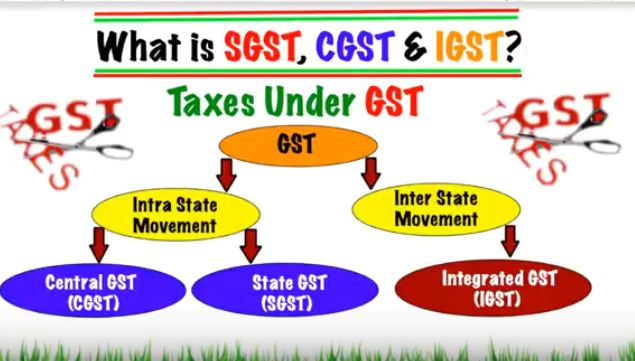
The Goods and Service Tax (GST) introduced in India brought about a good economic reform in terms of tax administration by creating a ‘one nation, one tax’ system. This form of taxation effectively removed the cascading effect of different taxes applicable at the central and state levels.
It subsumes various taxes such as service tax, excise duty, central sales tax, VAT etc. The different taxes levied at state and centre levels got consolidated into a uniform tax system with the introduction of GST. Thus GST managed to completely get rid of the drawback of tax-on-tax effect.
GST is a tax system that is destination based. The liability to pay GST falls on the end user who is the consumer of the goods or services. The state where such goods or services are consumed receives the tax and not the manufacturing state.
What are the components of the Goods and Service Tax?
The power to collect taxes rests with both the Central and the State Governments. The Central as well as the State Governments have diverse responsibilities for which collection of tax revenue is important. Hence under GST system, the Taxes are collected by both the Governments in an equal proportion. Following are the basic components of GST:
1. State Goods and Services Tax
The State Goods and Services Tax (SGST) is collected by the State Government. It is levied on the supply of Goods or Services Intra State. SGST falls under the purview of the State Goods and Service Tax Act.
(Intra-state supply is when the supply of goods or services is within a particular state. Intra state supply attracts both CGST and SGST and is collected from the buyer.)
2. Central Goods and Services Tax
The Central Goods and Services Tax (CGST) is levied on Intra State supply of goods and services at the Central Government level. CGST falls under the Central Goods and Services Tax Act.
3. Integrated Goods and Service Tax
Integrated Goods and Service Tax (IGST) is applicable on the supply of goods and services Inter-State. This tax is collected by the central government and is governed by Integrated Goods and Service Tax Act.
4. Union Territory Goods and Service Tax
Union Territory Goods and Service Tax (UTGST) is applicable for the supply of goods or services within a particular Union Territory.
State Goods and Service Tax (SGST) in brief
SGST is applicable on intra-state supply or transactions of goods or services within one state. This tax is levied by the state in which the goods or services are being sold or purchased. The State Government is benefitted by the tax revenue earned.
Rate of applicable Taxes:
- Traders and Manufacturers: 1% of turnover
0.5% SGST
0.5% CGST
- Restaurants (those that do not serve alcohol): 5%
2.5% SGST
2.5% CGST
- Service providers: 6%
3% SGST
3% CGST
Taxes under GST are collected by the Central and the State Government at equal rates. Different applicable GST tax slabs are 5%, 12%, 18% and 28% for different categories of goods or services.
Tax Collection System
Collection of taxes under this system is much easier as it falls under a single authority. Computing, collection and recording of the tax filings is all handled by this central authority. The Goods and Services Tax Network or GSTN forms the backbone of this system. GSTN has made everything digital and the taxes get distributed accordingly to the right Government funds.
Example of SGST applicability
X from Gujarat is involved in a sale of goods to Z in Gujarat.
Product price: Rs. 10,000/-
Applicable GST: 18%
Break-up:
CGST: 9%
SGST: 9%
The tax amount under SGST in this case is Rs 900 i.e. 9% of Rs 10,000. This tax amount will fully be claimed by the Gujarat State Government. The applicable rate of the goods after applying SGST to it will be Rs 10,900/-.
State Taxes replaced by SGST
- VAT
- Entertainment Tax
- State Sales Tax
- Luxury Tax
- State Cesses
- Entry Tax
- Taxes on betting, lottery or gambling
- Surcharges
Input Tax Credit System
The Goods and Service Tax system incorporated Input Tax Credit mechanism that helped eliminate the tax on tax effect. Input taxes are paid on supply of inputs in case of manufacturing or services. Input taxes may include IGST, SGST, CGST or UGST.
This mechanism makes sure that such taxes paid on inputs are deducted during the final transaction. The total tax payable is hence exclusive of such taxes paid on inputs.
How are the input taxes set off?
Input taxes are set off in a particular order:
- Against IGST liability
- Against CGST liability
- The remaining balance credit remaining after such set off against IGST and CGST is set off against SGST
Input tax credit is set off against SGST at the very end. The balance remaining after setting off IGST and CGST is set off against SGST. This helps remove the cascading effect of the tax system.
Conclusion
The Goods and Service Tax system has simplified the administration of taxes. It is a destination based tax system. The liability of paying the taxes hence lies with the end user who consumes such particular goods or services. The GST system of taxation ensures that the central as well as the state governments are in a position to raise the required amount of revenue to carry out the respective responsibilities.
Under the GST system, SGST, IGST, and CGST together serve two purposes i.e. ‘One Nation, One Tax’ which helps completely eliminate the cascading effect of taxes. Secondly, it brings into place a dual tax system that is crucial for both the Central as well as the State governments for the generation of tax revenue.
